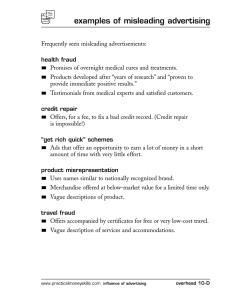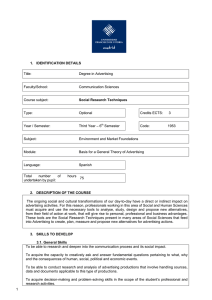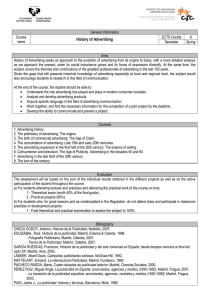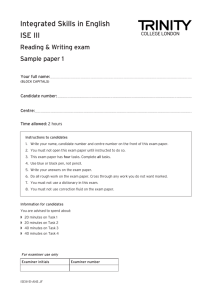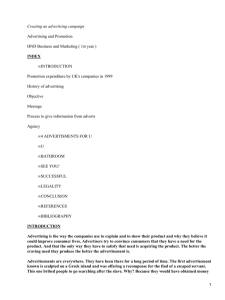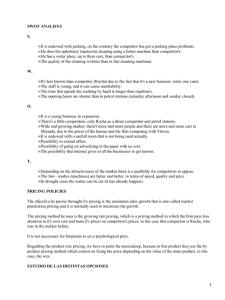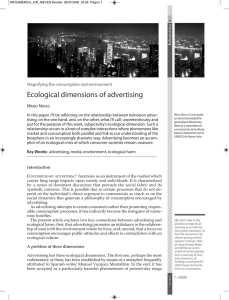Prevention of Waste from Unsolicited Mail in Households
Anuncio
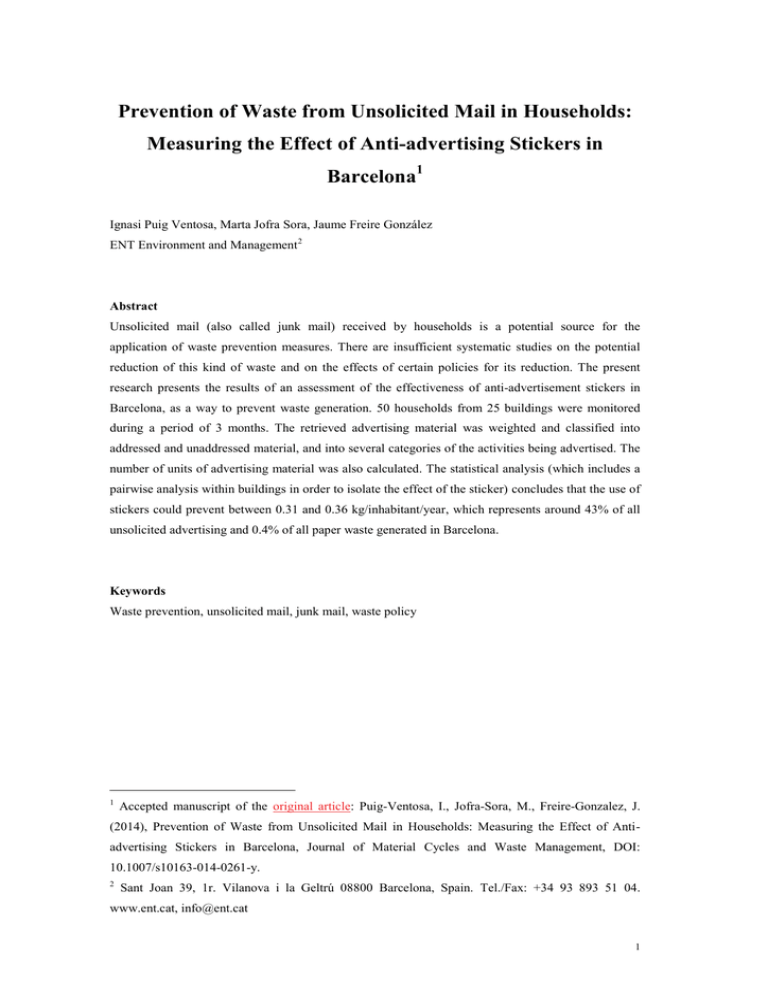
Prevention of Waste from Unsolicited Mail in Households: Measuring the Effect of Anti-advertising Stickers in Barcelona1 Ignasi Puig Ventosa, Marta Jofra Sora, Jaume Freire González ENT Environment and Management 2 Abstract Unsolicited mail (also called junk mail) received by households is a potential source for the application of waste prevention measures. There are insufficient systematic studies on the potential reduction of this kind of waste and on the effects of certain policies for its reduction. The present research presents the results of an assessment of the effectiveness of anti-advertisement stickers in Barcelona, as a way to prevent waste generation. 50 households from 25 buildings were monitored during a period of 3 months. The retrieved advertising material was weighted and classified into addressed and unaddressed material, and into several categories of the activities being advertised. The number of units of advertising material was also calculated. The statistical analysis (which includes a pairwise analysis within buildings in order to isolate the effect of the sticker) concludes that the use of stickers could prevent between 0.31 and 0.36 kg/inhabitant/year, which represents around 43% of all unsolicited advertising and 0.4% of all paper waste generated in Barcelona. Keywords Waste prevention, unsolicited mail, junk mail, waste policy 1 Accepted manuscript of the original article: Puig-Ventosa, I., Jofra-Sora, M., Freire-Gonzalez, J. (2014), Prevention of Waste from Unsolicited Mail in Households: Measuring the Effect of Antiadvertising Stickers in Barcelona, Journal of Material Cycles and Waste Management, DOI: 10.1007/s10163-014-0261-y. 2 Sant Joan 39, 1r. Vilanova i la Geltrú 08800 Barcelona, Spain. Tel./Fax: +34 93 893 51 04. www.ent.cat, info@ent.cat 1 1. INTRODUCTION Physical distribution of direct advertising takes different forms: in the mailbox, insertion between the pages of paper media, through free journals, delivery by hand, placement on vehicles in the streets, etc. Most of these advertising materials are unsolicited and often discarded without reading, and could be prevented, thus avoiding their contribution to waste generation. Waste prevention is leading the legal hierarchy of priorities in waste management policies in Europe, according to the Waste Framework Directive.3 In Spain and Catalonia this has also been introduced into their respective laws on waste.4 The Municipal Waste Management Program in Catalonia [1] includes a target for the prevention of municipal solid waste of 10% for 2012, compared to 2006 values, which means achieving a reduction of 60 kg per inhabitant per year. The Metropolitan Program of Municipal Waste Management for Barcelona 2009-2016 proposes a goal of "maintaining or reducing" waste generation levels within the metropolitan area at the end of the period covered by the plan through preventive measures. Furthermore, in Catalonia, the Law 9/2000, of 7 July, regulating dynamic advertising establishes the right of citizens to not receive advertising when it has expressly been requested to not be delivered. Within the law, dynamic advertising is defined as the communication carried out by public or private agents in the exercise of an economic activity, the aim of which is to foster the sales of any good or service, as well as rights and duties or messages of social, cultural or political nature, which is carried out by means of the direct contact with the potential buyers or customers. The law foresees the application of fines to companies that do not respect the citizen's right to not receive advertising, but currently only a few municipalities apply these fines. Conversations with some distributors show that the managers/directors of these companies are aware of the Law, but no information has been obtained in relation to which extent this knowledge is passed on to their employees. The City Council of Barcelona is aware of the goals of Law 9/2000 and has established the need to prevent waste from advertising materials in its Waste Prevention Plan, passed on 2012. The Municipality has carried out several activities, including the delivery of anti-advertising stickers, to be placed on mailboxes, or the regulation of advertising activities through municipal ordinances. The use of ‘no junk mail’ stickers is supposed to reduce the advertising material placed in mailboxes and, therefore, the waste derived from it. 3 Directive 2008/98/EC of the European Parliament and of the Council of 19 November 2008 on waste and repealing certain Directives. 4 Spanish Law 22/2011, of 28 July, on waste and contaminated soil, and Catalan Legislative Decree 1/2009, of 21 July, approving the revised text of the Law regulating waste. 2 The aim of this paper is to assess the effectiveness of these stickers in reducing unsolicited mail, analyzing to what extent they affect the amount and type of advertising material received at households. To analyze this, a number of households have been monitored in Barcelona. Section 2 provides a brief review of the literature related to waste generation from advertising materials and impacts of waste prevention measures addressing this fraction; Section 3 describes the methodology and the data collection process; Section 4 performs a statistical analysis of data; Section 5 contains a statistical analysis within buildings to control factors that affect the geographic distribution of advertising materials; Section 6 extrapolates the results for the whole city. Finally, Section 7 contains the conclusions of the research. 2. LITERATURE REVIEW The literature recognizes the importance of waste prevention (because it is at the top of the waste hierarchy) and the difficulty of measuring it [2, 3]. One of the possible household waste prevention measures considered in the literature is the reduction of waste from unsolicited advertising materials [2-4]. The method of monitoring waste prevention from unsolicited advertising as performed in this study could be considered a direct quantification of source reduction. This quantification can help in assisting policy makers and local authorities [2] when designing waste prevention actions, and particularly actions for the prevention of unsolicited advertising. According to a study conducted by the French Environmental Agency [6], 25% of paper consumption for advertising uses corresponds to addressed advertising in mailboxes, and 51% corresponds to unaddressed advertising (the rest of paper consumption being used for commercial catalogues -13%and other kinds of advertising materials -11%-). According to this study, advertising material received in households generates 10.31 kg of waste per inhabitant and year. In contrast, a guide on waste prevention published in 2012 by the same agency [7], estimates the amount of this kind of advertising material as 24 kg per household and year. Some of the reasons that may explain the difference between these figures are explained in Conclusions section of this paper. In Denmark, Hansen et al. [8] (as cited in [9]) estimated an amount of 55 kg of unsolicited mail received per household for year 2009. In a survey carried out in Vienna [10], composition analyses of residual waste and paper waste from 16 households showed that advertising material accounts for about 28 kg/cap/yr, 5 and concluded that each household refusing unaddressed advertising in the mailbox with a sticker could prevent about 33 kg of unaddressed advertising paper per annum. This prevention has been estimated to be achieved not only by means of the “stop-pub” sticker, but also by means of a prohibition of unsolicited advertising (which the authors term, "Advertising on request", i.e. a regulatory measure). Households 5 This included unaddressed and addressed advertising material, and not only material placed in the mailbox but also hung onto doors. 3 participating in this survey where interviewed, and results revealed that 53% of them found unsolicited advertising annoying, 63% would be in favor of banning the distribution of unaddressed advertising, and 47% did not want to ban the distribution of unsolicited advertising in general [11]. In a similar manner, Salhofer et al. [4] established the prevention potential of advertising materials, concluding that measures that improve the knowledge of households about the existing possibilities for cancelling the delivery of unsolicited advertising (i.e sticker on the door or on the mailbox) could reduce 13% of the relevant waste stream or 0.7% of total municipal solid waste in Vienna (4.7 kg/cap/yr). Sharp et al. [5] demonstrated that campaigns to reduce unsolicited mail in the Brussels region, including stickers and accompanying enforcement measures, achieved a reduction of 5 kg/household/year [12]. A similar scheme has been estimated to have the potential to reduce unsolicited mail of between 112,500 and 187,500 metric tons/year in the United Kingdom for year 2000 [13] (between 1.91 and 3.19 kg/cap/year). Other studies estimated a reduction of 0.2 to 0.4% through reducing (non-packaging) paper waste, including unsolicited mail ([14]; cited in [15]). 3. METHODOLOGY This study was carried out in the city of Barcelona, capital of the autonomous region of Catalonia (Spain). The city has 1.6 million inhabitants and is formed of 10 districts. Its economy is mostly based in the tourism and services sectors. Dynamic advertising is mainly distributed by private companies, directly or through postage companies. There is a national postal service, but it usually does not deliver unsolicited advertisement and cannot deliver unaddressed items. Newspapers and magazines are delivered to mailboxes to those citizens that have a subscription and they usually include unsolicited advertising, particularly during the weekend period. Some buildings have common mailboxes which are accessible to all residents, but most of them have individual mailboxes. However, in this case some buildings have a common mailbox for unsolicited advertising. Mailboxes are usually located inside the buildings, and distributors need to ask the neighbors to open the entrance door in order to access the mailboxes. However, some buildings have mailboxes outside or accessible from outside of the building. According to law, every person has the right to not receive addressed advertising by notifying specific organizations that they do not want to receive any advertising, or by joining an advertising exclusion list, also known as Robinson list or Mailing Preference Service (MPS) list. These are databases that, according to law, advertising distribution companies must check before carrying out the distribution of advertising. These lists are very little used by citizens; in Barcelona, only 8,913 inhabitants were enrolled onto the Robinson list in June 2012.6 6 Data provided by Asociación Española de la Economía Digital. 4 Advertising materials received in 50 households in Barcelona were collected for three months (between April 15th and July 15th 2012), in order to infer the amount of unsolicited mail received during the overall year, and then check the possible effectiveness of the stop-pub sticker. Participants were selected in a manner that would obtain enough representation from all districts of Barcelona, by including a number of households approximately proportional to the population of each district (Fig. 1). A total of 25 buildings were selected. The selection of the participants with a sticker was performed randomly, in asking them to volunteer for participation in the study. Once a participant was confirmed, a second participant without sticker in the same building was selected, in order to allow a pairwise analysis. This second participant was suggested by the first participant; participation was also on a voluntary basis. Having two participants within each building (one household with sticker and another without sticker) reduced the effects of the geographical location of the property on the amount and type of advertisement materials received. A before and after method for stickers was considered, but due to a lack of time and budgetary constraints, the methodology already described was chosen. Several criteria were established in order to ensure a homogeneous sample of buildings and a priori control of certain factors that could influence the distribution of advertising. Only the buildings fulfilling simultaneously the following three criteria were selected: - Buildings without doorkeeper, because the presence and behavior of the doorkeeper can influence the amount of publicity received in each household. - Buildings without the poster: "This community does not accepted publicity" (or similar) in the main entrance, since it affects the delivery of advertising materials to individual mailboxes. - Buildings with individual mailboxes for each household. All participants were provided two envelopes to in which to place the advertising materials received; asking them to separate addressed advertising materials from unaddressed. The shipping was accompanied with a letter from the City council with detailed instructions for participants, and with a phone number and an e-mail contact address for questions or comments. A sticker was also sent to those 25 participants who had to place it on their mailbox. Addressed advertising is considered as all advertising material directly addressed to any of the household members, including the following items: - Personalized advertising from banks, telephone companies, energy companies, stores where any of the household members are customers, etc. - Advertising that accompanies invoices, bank statements or communications (in this case only the advertising material was considered, not the invoice or statement). - Advertising that comes with other shipments that any member of the household has signed up for (e.g. together with newspapers or magazines). - Brochures and magazines from public authorities. 5 Complementarily, unaddressed advertising is defined as any advertising material placed in the mailbox and not specifically directed to any member of the household. Only materials inside the mailbox were considered, and not those left on the ground. The experiment took place between 15 April and 15 July 2012. Later, envelopes were collected, and advertising materials deposited inside them were classified, weighted and counted. 4. STATISTICAL ANALYSIS This section contains the statistical analysis of the collected data. Unsolicited advertising was separated into two categories: addressed and unaddressed advertising. 4.1. RESULTS RELATED TO ADDRESSED ADVERTISING Since most of the addressed advertising is delivered by postal services, it is expected that stickers will have only a minimum prevention effect on this kind of advertising material, compared to the effect on the unaddressed advertising materials, which are delivered in a more indiscriminate way. The advertising materials have been classified. The categories considered have been: telephone services; water, electricity and natural gas services; retailers; banks; institutional (information from public authorities) and others (Fig. 2). It can be observed that, in households with no sticker, most of the advertising comes from the category “Retailers”, while in households with sticker, advertising mostly comes from activities classified as “Others”. As Figure 2 shows, as regards addressed advertising, households with the sticker receive less advertising from “Retailers”, but more (in percentage) from “Banks”. The differences for other activities are not significant between those with the sticker and those without it. However, the observed variability suggests that the sticker may not have significant effects on addressed advertising. 4.2. RESULTS REGARDING THE UNADDRESSED ADVERTISING In this section we aim to test the hypothesis that unaddressed advertising materials should be affected by the use of stickers. In this case, in addition to the weight of advertising materials, the number of units (brochures, leaflets, etc.) has also been analyzed. Table 1 shows the main statistics obtained of the statistical analysis for unaddressed advertising materials, separating those with sticker from those without, both in terms of the number of units and of total weight. 6 The number of units and the total weight of advertising materials are 22.3% and 52.7% lower, respectively, in the households that have placed the sticker than in those which have not. All averages are significant at a confidence level of 95%. Pairwise t-tests show that there are no statistical differences between the two means when considering number of units (p value equals to 0.23), but they are statistically different when considering weights (p value 0.06). As in the previous section, an analysis of the advertising materials by type of activity has been carried out. In this case, the categories considered are the following: • Personal services: dentists, language schools, training centers, waxing services and/or hairdressing, geriatrics, etc. • Retailers • Home Services: locksmiths, painters, masons, removals, etc. • Real Estate agencies • Restaurants • Travel agencies • Institutional advertising (issued by public bodies): city council, regional government, etc. • Other: anything not included in the above categories: insurers, lawyers, clairvoyants, etc. Figures 3 and 4 show amount of advertising by type of economic activity, both in number and weight, in Barcelona. It can be observed that most of the distributed materials to mailboxes with sticker come from restaurants, followed by home services, personal services and retail. Mailboxes without sticker have a similar distribution of unaddressed advertising, but in this case, retail are in the first position, followed by restaurants, personal services and home services. The figures may be suggesting that the highest share of advertising comes from retail in households with no sticker, and therefore the greater sensitivity of these economic activities to the sticker. Figure 4 shows that most of the brochures distributed to mailboxes with sticker in weight (51%) are retail, followed far behind by travel agencies, restaurants and personal services. However, in mailboxes without sticker, 67% comes from retail, followed by restaurants, travel agencies and personal services. Similar to what happened when measuring the number of units, advertising materials from retail measured in weight also seem more sensitive to the existence of the sticker. Unaddressed advertising clearly diminishes in mailboxes with the sticker compared to those that do not have it. The biggest incidence is observed in relation to advertising materials from retail, personal services and restaurants. 7 Moreover, the average weight of the analyzed advertising materials is 9.6 g per unit, in the case of unaddressed advertising. However, there is a considerable dispersion. Figure 5 shows the average weight of unaddressed advertising for the different categories of advertising materials. 5. STATISTICAL ANALYSIS WITHIN BUILDINGS Pairwise comparisons between households with and without sticker in each building are important, in order to control geographical factors affecting the distribution of advertising materials. Since each building includes one household with a sticker and another one without sticker, pairwise comparisons have been made using the percentage difference between them in relation to the amount of advertising materials received. Subsequently, an average has been calculated. The result of this study, in terms of the quantity of advertisement material received by households, is significantly lower than those obtained in previous studies [6-8, 10]. In relation to this, some aspects with respect to the present research have to be taken into account: - the sampling took place over a period of three months and some of the bulkier deliveries of advertising materials that arrive in certain periods of the year (e.g. toys or furniture catalogues) were not captured in the analyzed period; - the economic crisis could also affect the results: according to a report on the advertisement sector in Spain, which is published on a yearly basis [16], the expenditure in the mailbox advertising subsector dropped by 25% between 2007 (18,39 €/inhabitant) and 2012 (13,70 €/inhabitant); - only advertisement materials put inside mailboxes were taken into account; however, a quantity of materials is found on the entrance floor; - the study has only taken households into account; however, business and service companies also receive advertisement materials; - distribution of advertising in Barcelona may be different from other cities or countries. According to Infoadex's report [16], in Spain the expenditure in the mailbox advertising subsector represented only 5.91% of the total investment of the advertisement sector in 2012. Since each building has one household with sticker and another without sticker, a pairwise analysis has been performed using the percentage variability, in terms of received unaddressed advertising materials in each of the households. Then, an aggregation has been performed. Regarding unaddressed advertising in weight, 18 from the 22 buildings (i.e. 82% of cases),7 households with sticker have less advertising than households without sticker, getting an average of 158% more, i.e., those households without sticker had about 2.5 times more advertising than those 7 Three of them have been deleted, because they either have not correctly provided the advertising materials or have left the experiment before finishing. 8 with sticker. Table 2 shows the summary statistics for the variation of unaddressed advertising in weight from households without sticker compared to households with sticker. Regarding unaddressed advertising measured in number of units, in 13 of the 22 buildings (i.e. 59% of cases), households without sticker received more advertising than households with sticker, with an average of 40.73% more. 6. EXTRAPOLATION OF RESULTS FOR THE CITY OF BARCELONA From the results presented above, an estimation of the quantities of waste received by each household throughout the year has been made. It has been assumed that currently only 10% of households have a stop-pub sticker,8 and then an extrapolation of the amount of advertisement material received in an average household for a period of three months to what could be assumed for the whole year has been carried out. It has been assumed that the sticker has only an effect on the reduction of unaddressed advertising. Thus, the amount of advertising materials that reach mailboxes in Barcelona is estimated to be 1,370 metric tons per annum, 26% of which would correspond to addressed advertising, and 74% to unaddressed advertising. Advertising materials per household are estimated to be 2.08 kg per annum, 1.54 kg being unaddressed advertising and 0.55 kg addressed advertising. The quantity of waste that stickers might potentially save yearly has also been estimated for the whole city, assuming that 100% of households would have the sticker. The results depend on whether we use the statistical analysis carried out in Sections 4 or 5. In the first case, which considered the two groups of households (with and without sticker) of all the buildings together, the reduction would be 505.87 metric tons of advertising. This would mean 0.31 kg/inhabitants/year. This represents 0.06% of the total waste generated in Barcelona in 2011. Considering that paper represents 18% of total waste generation in Catalonia [1], the amount prevented would be around 0.35% of all paper waste generated in the city of Barcelona. If we use the results of the statistical analysis within buildings performed in Section 5, the reduction would be of 587.58 metric tons of advertising. This would mean around 0.36 kg/inhabitants/year. This represents 0.07% of the total waste generated and around 0.41% of all paper waste generated in Barcelona in 2011. Although the amount of waste prevented is relatively low in relation to the total amount of waste produced in the city, the cascading effect of waste prevention has to be taken into account at the time 8 Information provided by several advertisement distribution companies. 9 of evaluating these results. In this sense, Gentil et al. [17] evaluated this effect, taking into account the indirect affected systems following this waste prevention measure (e.g. reduction of virgin paper production), and concluded that prevention measures generate additional benefits when a cascading effect is considered. Even though cascading effect of advertising prevention is not higher than that of other waste prevention measures, the existence of this effect helps decision makers to justify the implementation of measures for the prevention of unsolicited advertising. 7. CONCLUSIONS The above analysis showed that households with the sticker receive significantly less advertisement materials than those without it, particularly when considering weight of material received. This suggests that the distribution of stickers may be a good policy for the prevention of waste from advertising materials. However, to consider all variables that affect the distribution of advertising materials, and then, to know the specific effects of stickers, a more complex statistical model should be developed. Specifically, this would mean a regression model explaining and trying to quantify the effect of the sticker on the distribution of advertising, among other possible factors such as income of the households, economic structure of the district where the household is located, etc. In that respect, depending on the socio-economic level of the neighborhood, there is more presence of certain types of activities that use advertising. Besides, low income neighborhoods are not so likely to be a target of advertising due to their low purchasing capacity. The methodology of the study (which includes pairwise t-tests), the systematic collection of data, and a follow-up throughout the sampling period make the results robust in relation to the amount of unsolicited advertising received in household mailboxes. Furthermore, the study has addressed some novel questions that had not been addressed by other studies in the past, such as the calculation of the number of units of advertising material received (notwithstanding its weight) which, together with a disaggregation of the amount of materials received by categories, makes it possible to identify the average unitary weight of the advertisement materials, as well as the origin of the advertising. Another particularity of the study is the separation between addressed and unaddressed advertisement, which makes it possible to prove that unaddressed material is more frequent and comes from a different source than addressed advertising. In contrast, the selection of pairs of households inside a same building has allowed a pairwise analysis that can isolate the effect of the sticker from other factors that influence the distribution of advertisement materials. 10 For further research, it would be interesting to use the methodology applied in this study in order to assess the effect of the stickers in other countries where there is legislation regulating unsolicited advertising.9 ACKNOWLEDGEMENTS This article derives from a project funded by the Barcelona City Council. We would like to thank the contributions of Carles Vázquez, Núria Fradera and Helena Barracó, as well as the collaboration of all the persons that participated in the sampling. The authors also wish to thank the comments received from three anonymous reviewers and from Dr. Matthew Copley. REFERENCES [1] ARC (2007) Programa de gestió de residus municipals a Catalunya. PROGREMIC 2007-2012. Departament de Medi Ambient i Habitatge - Generalitat de Catalunya, Barcelona. [2] Zorpas A, Lasridi K (2013) Measuring waste prevention. Was Man 33: 1047-1056. http://dx.doi.org/10.1016/j.wasman.2012.12.017 [3] Read M, Gregory M K, Phillips P S (2009). An evaluation of four key methods for monitoring household waste prevention campaigns in the UK. Res Con Rec 54: 9-20. DOI: 10.1016/j.resconrec.2009.05.004. [4] Salhofer S, Obersteiner G, Schneider F, Lebersorger S (2008) Potentials for the prevention of municipal solid waste. Waste Management 28:245-259. http://dx.doi.org/10.1016/j.wasman.2007.02.026, [5] Sharp V, Giorgi S, Wilson D C (2010) Delivery and impact of household waste prevention intervention campaigns (at the local level). Waste Manage Res 28(3):256-268. doi: 10.1177/0734242X10361507 [6] ADEME (2007) Le gisement des emballages ménagers en France, Evolution 1994/2006. Agence de l'Environnement et de la Maîtrise de l'Energie, France. [7] ADEME (2012) Réduire ses déchets et bien les jeter. Agence de l'Environnement et de la Maîtrise de l'Energie, France. [8] Hansen MS, Bakas I & Kjær B (2010) Baggrundsmateriale til Miljøstyrelsens affaldsforebyggelseskampagne 2010. 3. Udkast. Copenhagen Ressource Institute, Copenhagen. [9] Martinez Sanchez V, Møller J (2011) LCA on the prevention of unsolicited mail in the Vestforbrænding municipalities. Department of Environmental Engineering, Technical University of Denmark, Lyngby. 9 One of these countries is Korea, where some kinds of advertisement leaflets have been prohibited [19]. 11 [10] Wassermann G, Schneider F, Hingsamer R, Steyer F, Zinöcker K (2004) Werbung auf Wunsch – Modellversuch zur Erprobung von Maßnahmen gegen die Zustellung unerwu¨nschten Werbematerials (Advertising on request – model test for measures against unsolicited advertising), on behalf of the Initiative ‘‘Abfallvermeidung in Wien’’. Vienna, Austria. [11] Wassermann G, Schneider F, (2005) Waste minimisation potential through the limitation of unwanted mail advertising. In: Cossu R, Stegmann R (ed), International Waste Management and Landfill Symposium, 10th edn. St. Margharita di Pula, Cagliari, Sardinia, Italy. [12] ACR+ (2008) Analysis of Municipal Waste Management Practices in Europe – an Image of some of the Best Performing Cities and Regions. Association of Cities and Regions for Recycling and Sustainable Resource Management (ACR+), Brussels. http://members.acrplus.org/upload/documents/document221.pdf. [13] Eunomia, The Environment Council, Öko-Institut, TNO and Atlantic Consulting (2007) WR0103: Household Waste Prevention Policy Side Research Programme. A project for DEFRA’s WREP. [14] NRWF (2004) Waste Minimisation Toolkit. For the latest version redeveloped by WRAP, see: http://www.wrap.org.uk/applications/waste_prevention_toolkit/restricted.rm [15] Tucker P, Douglas P (2007) WR0112: Understanding Household Waste Prevention Behaviour. Final Report & Technical Reports 1–4. A project for DEFRA’s WREP. [16] Infoadex (2013), Estudio Infoadex de la inversión publicitaria en España 2013. Infoadex, Madrid. [17] Gentil E C, Gallo D, Christensen, T H (2011) Environmental evaluation of municipal waste prevention. Waste Manage 31:2371-2379. doi: 10.1016/j.wasman.2011.07.030. [18] Kim, I.C. (2002), Korea's policy instruments for waste minimisation. J Mater Cycles Waste Manag 4: 12-22. DOI: 10.1007/s10163-001-0060-0. 12 Fig 1 Map of Barcelona with the location of participating households 13 Fig 2 Percentage distribution of addressed advertising brochures by type of economic activity during the period of study (3 months), in weight 14 Fig 3 Percentage distribution of unaddressed advertising brochures by type of economic activity during the period of study (3 months), in number of units 6.86 Other 8.95 0.93 0.62 Institutional 3.37 4.32 Travel agencies 24.42 24.69 Restaurants 6.74 Real estate Without sticker 10.03 With sticker 15.23 Home services 20.83 Retail 25.12 13.89 17.33 16.67 Personal services 0 5 10 15 20 Percentage of units 25 30 15 Fig 4 Percentage distribution of unaddressed advertising brochures by type of economic activity during the period of study (3 months), in weight 6.30 Personal services 10.43 2.98 3.73 Other 0.66 0.48 Institutional 4.46 Travel agencies 8.91 6.83 Restaurants Without sticker 13.29 With sticker 2.91 5.26 Real estate 3.19 6.83 Home services 72.66 Retail 51.08 0 10 20 30 40 50 Percentage of units 60 70 80 16 Fig 5 Average unitary weight of unaddressed advertising material by categories of advertisement Average unitary weight (g/brochure) 35 30 25 20 15 10 5 0 17 Table 1. Main statistics for unaddressed advertising in households with and without sticker, during the analyzed period Number of units Statistic Without With sticker sticker Total weight (g) Without With sticker sticker Average 26.47 34.08 192.17 405.96 Standard deviation 12.59 22.56 187.55 497.49 Minimum 9.67 11.33 11.00 11.00 Maximum 53.00 83.50 673.00 1,656.00 Median 23.00 28.75 103.00 164.00 Kurtosis 1.00 1.55 1.15 1.19 Skewness 0.93 1.37 1.38 1.55 Level of confidence (95%) 9.01 16.14 81.10 215.13 Pairwise t-test Number of units Total weight (g) 40 28 t-statistic 1.20 -1.92 P(T<=t) two-tailed 0.23 0.06 Critical value 2.02 2.04 Degrees of freedom Source: Own elaboration. 18 Table 2. Main statistics of the variation of unaddressed advertising in households without sticker compared to those with it, in weight. Pairwise comparison of households within the same building. Statistic Variation in number Variation in weight Average 40.73% 157.53% Standard deviation 93.40% 256.61% Minimum -100.00% -68.00% Maximum 300.00% 1,071.43% Median 16.00% 50.53% Kurtosis 1.27 7.31 Skewness 1.07 2.51 Level of confidence (95%) 0.39 1.14 Source: Own elaboration. 19
